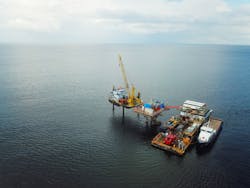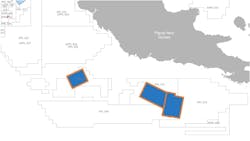NORTH AMERICA
PGS was due to start work last month on three new 3D seismic surveys offshore Newfoundland and Labrador, covering a total area of around 10,000 sq km (3,861 sq mi). The Ramform Atlas and Ramform Titan should complete the Blomidon, South Bank and Torngat Extension GeoStreamer surveys by early September, with final products expected in early 2021.
***
The drillship Maersk Valiant has discovered oil for Repsol via two wells in block 29, 88 km (55 mi) offshore from Mexico’s Tabasco coast. Polok-1 and Chinwol-1 were drilled 12 km (7.4 mi) apart in water depths of 583 m and 464 m (1,913 ft and 1,522 ft), with combined net pay of around 350 m (1,146 ft). The vessel was due to spud a follow-up well for Repsol on another prospect in block 10 off Veracruz.
Qatar Petroleum has agreed to farm into 30% of Total’s interest in offshore blocks 15, 33, and 34 in Mexico’s Campeche basin. All are within 30-90 km (19-56 mi) of the Cantarell and KMZ oil fields in water depths of up to 1,100 m (3,609 ft).
***
Stena Drilling will provide a sixth-generation rig to drill Bahamas Petroleum Co.’s (BPC) first exploration well offshore The Bahamas, Perseverance #1. BPC was forced to postpone its original campaign scheduled for this spring, due to the impact of COVID-19, but now expects the program to start between mid-December and early February 2021. Drilling, which could last up to 45 days, will target 770 MMbl of recoverable oil.
CARIBBEAN SEA/SOUTH AMERICA
Aquaterra Energy is conducting front-end engineering and design (FEED) for DeNovo Energy for a second minimal facility Sea Swift platform off the west coast of Trinidad and Tobago. The single-well conductor-supported platform will be installed on the Zandolie gas field in 20 m (65.6 ft) water depth, and will be lighter and smaller than the first facility that Aquaterra delivered in 2018 for DeNovo’s Iguana gas field.
***
ExxonMobil has farmed into 50% of block 52 in the Suriname-Guyana basin offshore Suriname, but Petronas will remain operator. Previously, Petronas drilled the Roselle-1 well on the block, and the company was planning to drill another prospect during the current quarter. The shallow-deepwater concession is thought to hold potential for multiple play types.
***
Petrobras has proven more oil at two of its largest producing fields offshore southern Brazil. Well 9-AB-135D-RJS on the Albacora field in the presalt Campos basin, 184 km (114 mi) offshore Macaé, delivered light oil from a depth of 4,630 m (15,190 ft). The other well, 9-BUZ-39DA-RJS was on the southeastern portion of Buzios, the company’s most prolific ultra-deepwater field in the presalt Santos basin.
In addition, Petrobras has been conducting extended well tests of Albacora and on the Farfan area, 70 km (43 mi) off the coast of Sergipe, to analyze oil characteristics and reservoir behavior. The Farfan test is the company’s first in ultra-deepwater offshore northeast Brazil.
***
Uruguay’s regulatory agency ANCAP has awarded BPC an exploration license for the AREA OFF-1 block. During the initial four-year period BPC will reprocess around 2,000 km (1,243 mi) of legacy 2D seismic and conduct new geotechnical studies: the block is 100 km (62 mi) from the coast in water depths of 20-1,000 m (66-3,281 ft). Chevron previously drilled two wells in the area in 1976.
***
Premier Oil and its partners have agreed to suspend activity on Phase 1 of the Sea Lion oilfield development in the offshore North Falkland basin to minimize expenditure in the current market conditions. All technical studies have been completed and all work fully documented: a reduced team is continuing with commercial and government negotiations.
WEST AFRICA
Aker Energy Ghana has reaffirmed its commitment to developing the deepwater Pecan oilfield offshore Ghana, despite cancelling a letter of intent for an FPSO in March, one month after making the award. The company and its partners are now working with the government on a revised, phased concept involving one FPSO for the southern part of the field, connected to a subsea production system in 2,400-2,700 m (7,874-8,858 ft) water depth. A second floater could be added a few months later in the north, tying in additional discovered resources.
Ghana’s government is calling for a unitization agreement between the producing Sankofa field (operated by Eni) and the Afina field, discovered late last year by local company Springfield Energy in 1,030 m (3,379 ft) water depth. The two discoveries, in adjoining licenses, reportedly share the same Cenomanian reservoir. Springfield estimates resources at Afina as 1.5 Bbbl of oil and 700 bcf of gas.
***
Nigeria’s Department of Petroleum Resources has opened the country’s marginal fields bid round, offering 57 fields in shallow water, swamp, and onshore terrains.
***
Total and Odfjell Drilling agreed to delay mobilization of the harsh environment semi Deepsea Stavanger from Norway to South Africa for a multi-well deepwater exploration campaign, due to global developments. The rig was due to spud a well on the Luiperd prospect in block 11B/12B during 3Q, part of a campaign targeting de-risked submarine fan structures.
EASTERN EUROPE
GAZ-SYSTEM has contracted Saipem to install the new Baltic Pipe between Denmark and Poland: the pipeline will transport gas from Norwegian field to these and neighboring countries. Saipem will perform S-lay of around 275 km (171 mi) of concrete-coated pipes in water depths of 4-57 m (13-187 ft). Following pre-lay surveys this year, installation should start in 2021, with the entire pipeline system due to be handed over for operation in late 2022.
***
Vancouver-based Trillion Energy is working on a redevelopment of its shallow-water South Akcakoca Gas-Basin fields offshore northwest Turkey in the Black Sea, which came onstream in 2007. Recently the company lowered producing pressure to extend the lives of the Phase I and II wells. It now plans to raise production through accessing additional proven gas reserves.
***
Lukoil has installed the jacket for the accommodation platform for its V.I. Grayfer field in the Russian sector of the Caspian Sea. The jacket, designed to withstand strong ice loads, was built in Astrakhan and transported to the field location via the Volga-Caspian shipping canal. Lukoil expected to install another jacket for the main platform later this year, followed by the topsides for the two facilities in 2021.
MEDITERRANEAN SEA
Saipem’s Castoro Sei has laid the 105-km (65-mi) offshore section of the Trans Adriatic Pipeline (TAP) across the Adriatic Sea. The pipeline system, with a total length of 878 km (545 mi), will transport gas from the BP-operated Shah Deniz II field development in the Azeri sector of the Caspian Sea to countries in southern Europe. It connects with the Trans Anatolian Pipeline at the Turkish/Greece border, then crosses Greece and Albania to the Adriatic coast before terminating in southern Italy. The offshore section, comprising close to 9,000 36-in. pipes, is in water depths of up to 810 m (2,657 ft). First gas should flow to Europe by the end of this year.
***
Allseas’ Solitaire has completed installation of the 90.3-km (56-mi) pipeline that will take gas from Energean’s Karish/Tanin fields to the Israeli mainland. Maximum water depth along the route is 1,700 m (5,577 ft). TechnipFMC’s Normand Cutter installed the subsea production manifold: later this year, installation will start on connecting the risers to the first three producing wells to the FPSO Energean Power. Topsides integration with the hull at the Admiralty Yard in Singapore, however, has been slowed by COVID-19 restrictions.
MIDDLE EAST
WesternGeco has acquired what was reportedly the first ocean bottom nodes survey offshore Egypt, over the Neptune Energy-operated North West El Amal block in the central Gulf of Suez. The survey, said to have been the most detailed since the first seismic was shot over the block in 1988, was designed to improve imaging of complex salt geometries ahead of future exploratory drilling.
***
McDermott International has secured FEED work from an unnamed Middle East client concerning two offshore riser platforms and brownfield integration/modifications.
ASIA/PACIFIC
Mubadala Petroleum and Tap Oil have committed to add three new production wells this year at their Manora oilfield in the Gulf of Thailand, using the jackup Valaris 115. The rig has also been conducting workovers on existing wells.
***
CNOOC has started production from two field developments in the Bohai region of the South China Sea. The Penglai 19-3 oilfield area 4 adjustment/Penglai 19-9 oilfield phase II project, in water depths of around 28 m (92 ft), involved installation of a new wellhead platform which will eventually be connected to 47 wells, with production of around 15,681 b/d sent to existing facilities for processing. Qinhuangdao 33-1S, in the central/western Bohai region, also produces through a new wellhead platform linked to in-place infrastructure.
In addition, the company has installed a replacement FSO - HYSY121 - at its Lufeng oilfield in the South China Sea. The vessel incorporates a disconnectable turret system, designed by SOFEC and integrated at the Shenzhen yard in China, to ensure safe suspension of operations at the typhoon-prone offshore location.
AUSTRALASIA
PGS’ Ramform Hyperion has acquired more than 6,100 sq km (2,355 sq mi) of seismic data offshore Papua New Guinea. The Panimaut program focused on various play types in the little-explored Papuan basin, targets including Tertiary carbonate build-ups and Mesozoic rift basins adjacent to the Papuan and Eastern plateaus. The company expects to release the resulting full integrity GeoStreamer data early next year.
About the Author
Jeremy Beckman
Editor, Europe
Jeremy Beckman has been Editor Europe, Offshore since 1992. Prior to joining Offshore he was a freelance journalist for eight years, working for a variety of electronics, computing and scientific journals in the UK. He regularly writes news columns on trends and events both in the NW Europe offshore region and globally. He also writes features on developments and technology in exploration and production.


